Oil Tank Accessories Explained

Welcome to our world of top-quality oil tank accessories!
We take pride in offering a comprehensive range of products designed to enhance the functionality and security of your oil tank. Whether you need accurate fuel gauges to monitor your oil levels, reliable oil tank alarms to ensure timely notifications, or sturdy oil tank lids and caps for added protection, we have you covered.
Our fittings are crafted with utmost precision and adhere to the highest industry standards, guaranteeing durability and peace of mind. Explore our collection and discover the perfect solutions to meet your oil tank needs.
Contents Gauges
Float Clock Contents Gauge
A float clock contents gauge is a device used to measure the level of liquid in a tank, such as an oil tank. It typically consists of a float connected to a measuring tape or chain. As the liquid level rises or falls, the float moves accordingly, providing a visual indication of the tank's contents.
Clock Gauges
Clock gauges, also known as clock-type tank level indicators, are instruments used to monitor the liquid level in a tank. They feature a dial with numerical markings that correspond to specific liquid levels. A float or a probe inside the tank is connected to the dial, and as the liquid level changes, the dial displays the corresponding level on the gauge.
Smart Monitoring
Smart monitoring refers to the use of advanced technology and sensors to remotely monitor and manage oil tanks. It typically involves the integration of sensors, communication devices, and software applications to collect real-time data on various parameters such as oil levels, temperature, and pressure. Smart monitoring systems enable users to access and analyse tank data remotely, receive alerts or notifications for abnormal conditions, and optimize oil management for improved efficiency and convenience.
Sight Gauges
Sight gauges are transparent or translucent tubes or columns that are attached to the side of an oil tank. They provide a visual indication of the oil level inside the tank. By observing the height of the oil within the sight gauge, users can quickly and easily determine the approximate oil level without the need for complex measurement devices or electronic systems.
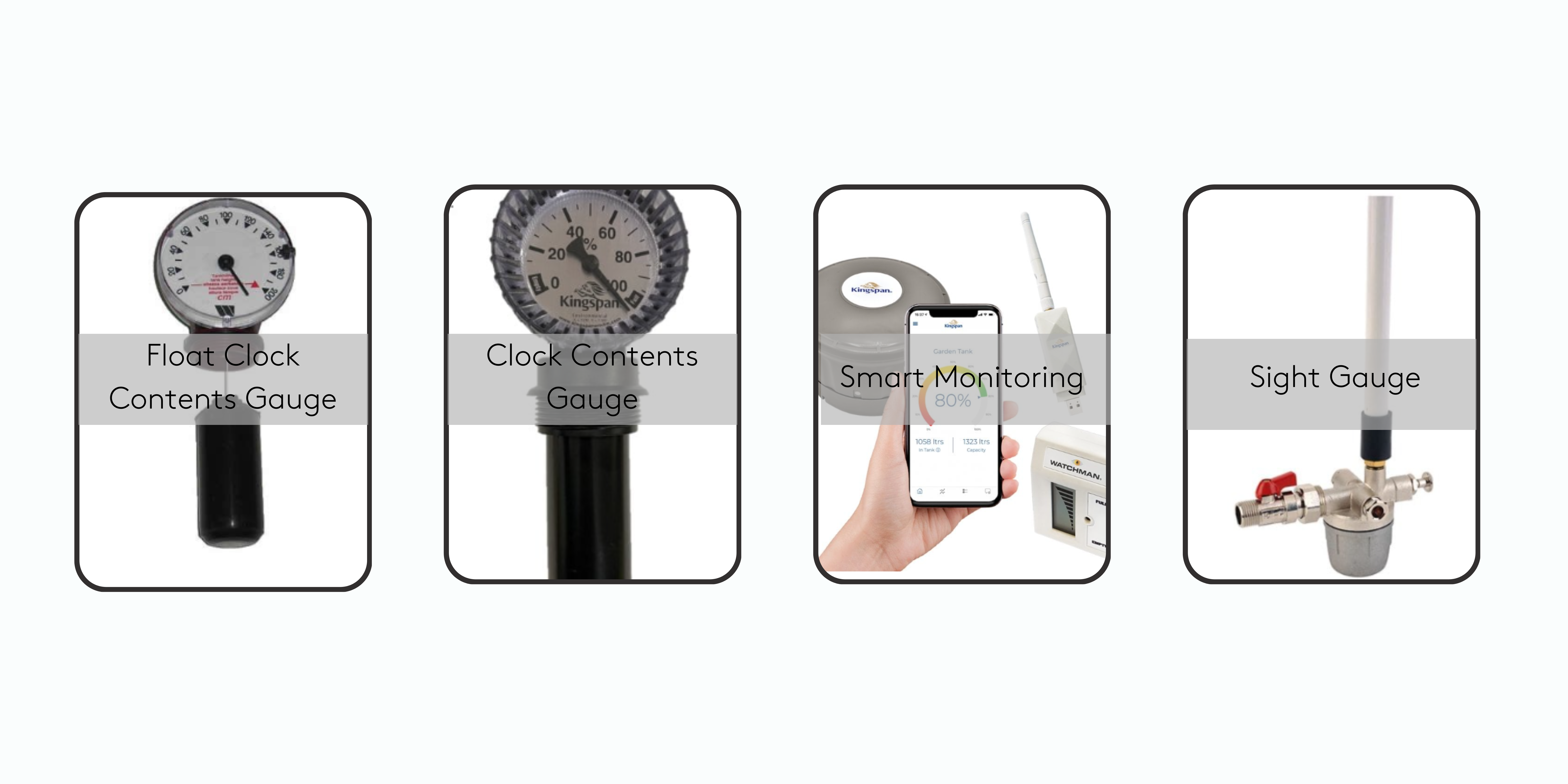
Tank Fitting Kits
Bottom Outlet Kits
Bottom outlet kits are sets of fittings and components that allow for the installation of a bottom outlet connection on an oil tank. A bottom outlet provides an alternative access point for drawing oil from the tank, typically located at the lower part of the tank. These kits include valves, connectors, seals, and other necessary components for a secure and efficient bottom outlet installation.
Offset Fill
Offset fill refers to a fitting or reducer that allows for the connection of a fill pipe to an oil tank when the fill point is not directly aligned with the pipe's entry point. It allows for flexibility in the positioning of the fill pipe, enabling easier and more convenient filling of the tank while ensuring a secure and leak-free connection.
Tank Reducers
Tank reducers, specifically offset fill tank reducers, are fittings used to modify the size or type of the fill point on a tank. They allow for the connection of different-sized hoses or pipes for filling or emptying the tank. Offset fill tank reducers are designed to provide flexibility in adapting the fill point to match the available fittings or connections.
Isolation Valves
Isolation valves are devices used to control the flow of fluid through a pipe or a system. In the context of oil tanks, isolation valves are installed at strategic points to enable the isolation or shutdown of oil flow when necessary. They provide a means to stop or regulate the oil supply, allowing for maintenance, repairs, or safety measures to be carried out effect.
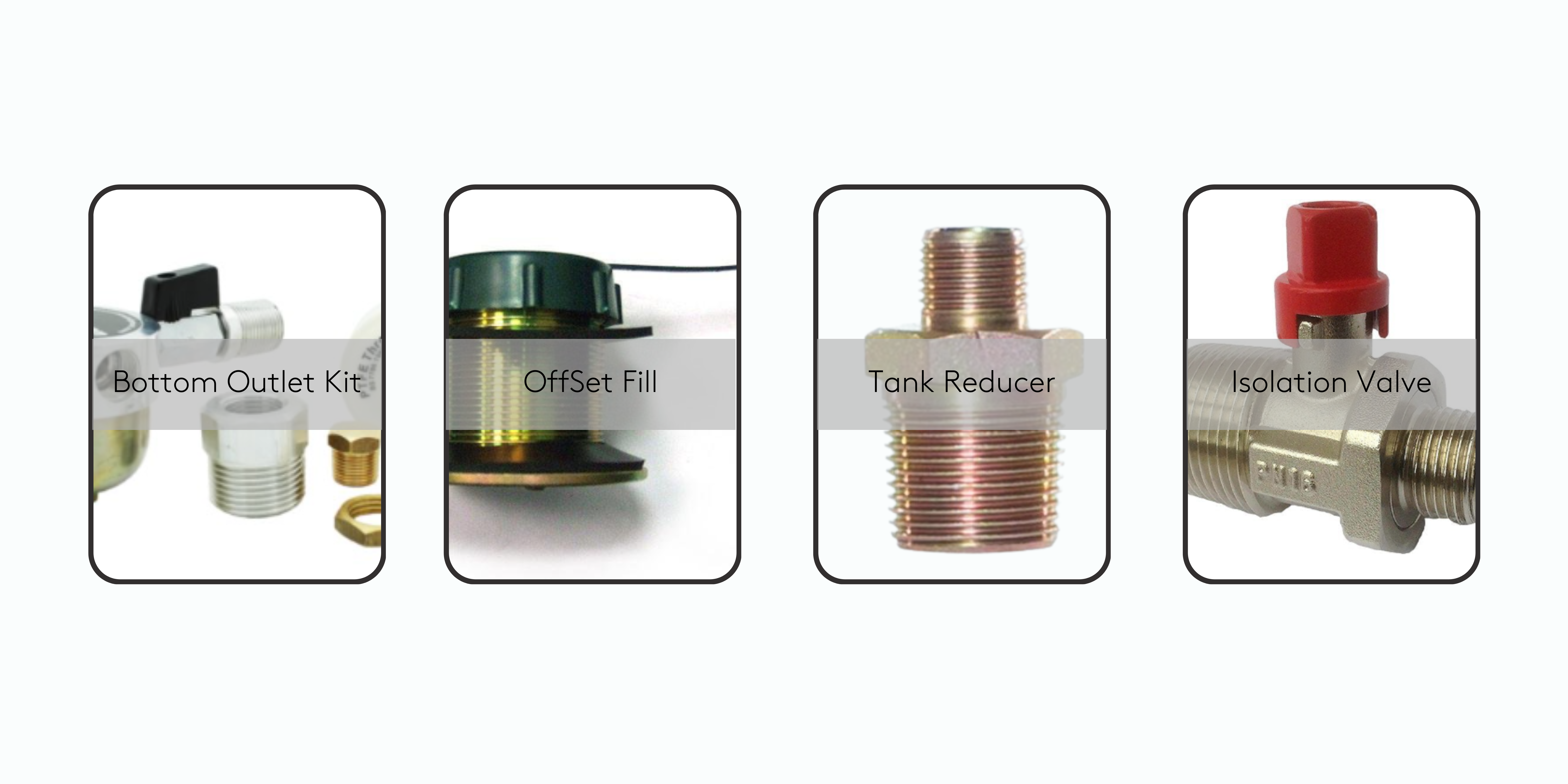
Flow Meters
Mechanical Oil Meter
Mechanical oil meters are devices used to measure the quantity of oil flowing through a system. They typically consist of a mechanical mechanism that converts the flow of oil into rotational motion. This motion is then translated into a numerical reading on a display, indicating the volume of oil passing through the meter. Mechanical oil meters are commonly used in industries such as oil and gas, automotive, and manufacturing for accurate oil consumption measurement and monitoring.
Flow Meters
Flow meters are instruments used to measure the flow rate of liquids or gases in a system. They operate based on various principles, including mechanical, electromagnetic, ultrasonic, or thermal techniques. In the context of oil applications, flow meters are used to measure the volume or mass of oil flowing through pipelines, tanks, or machinery. This information is crucial for monitoring oil consumption, optimizing processes, and ensuring efficient operation.
Pulse Meter
A pulse meter, also known as a pulse output meter or a digital pulse meter, is a type of flow meter that generates electrical pulses proportional to the flow rate of a liquid or gas. These pulses can be counted and used for further calculations or integration with other monitoring systems. Pulse meters are often used in oil and fuel industries to provide accurate flow rate measurements and enable remote monitoring and control of oil flow. They are particularly useful in applications where digital data integration and automation are required.
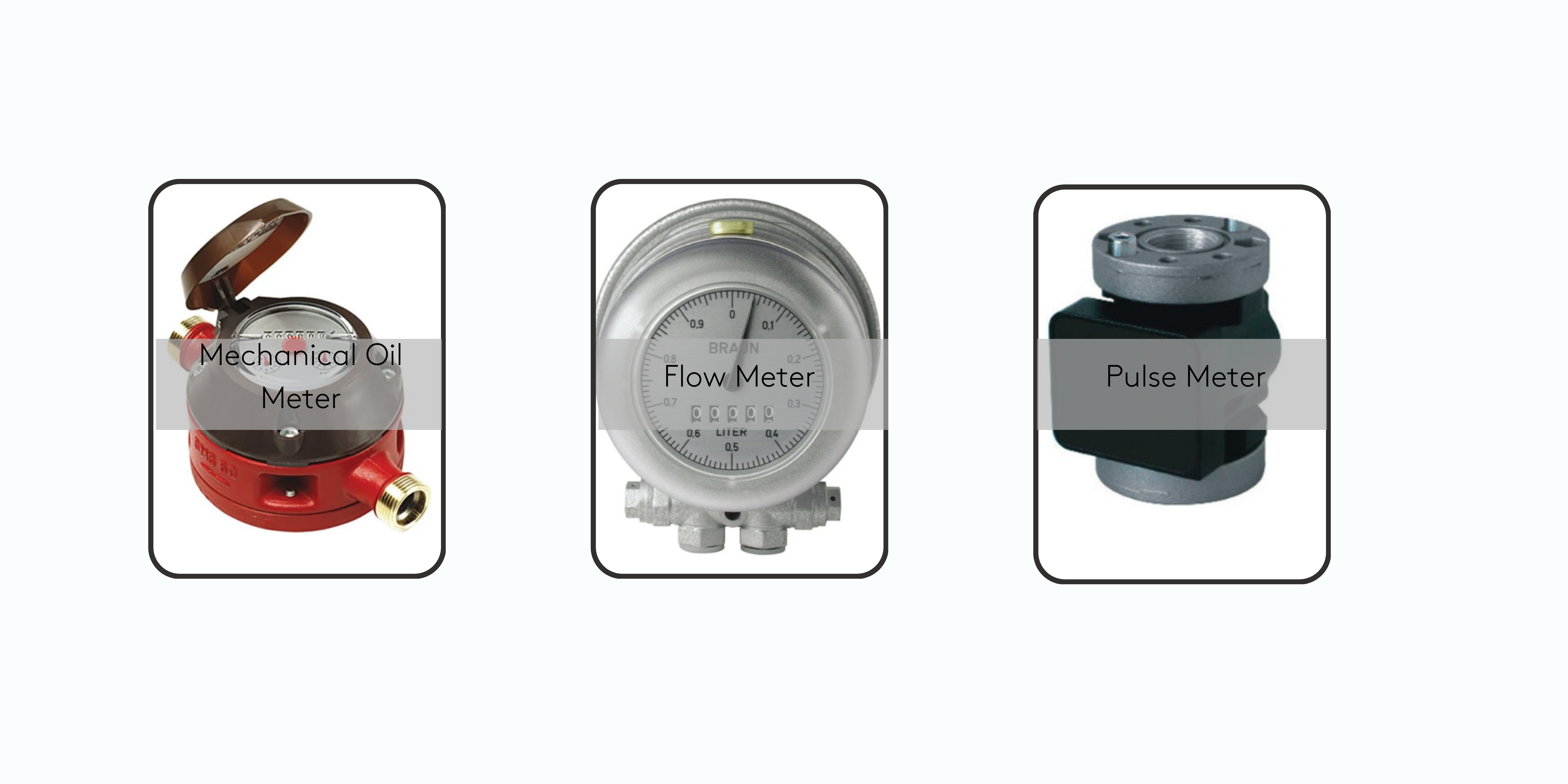
Bund Alarms
ATEX Certfied Bund Alarms
ATEX certified bund alarms are specialized alarms designed for use in potentially explosive atmospheres. They are used in bunded areas or secondary containment systems around oil tanks to detect leaks or spills. These alarms provide early warning notifications by emitting audible and visual signals when liquid levels exceed a certain threshold, helping to prevent environmental contamination and ensure compliance with safety regulations.
Visual Bund Unit
A visual bund alarm is an alarm system specifically designed for bunded areas or secondary containment systems around oil tanks. It typically consists of a visual indicator, such as a flashing light or an illuminated panel, that alerts users when the bunded area reaches a specific oil level. Visual bund alarms provide a visual warning to prevent overfilling or leakage in the bunded area, helping to avoid environmental contamination and ensure compliance with safety regulations.
Multi Compartment Fuel Tank Alarm
A multi-compartment fuel tank alarm is an alarm system designed for fuel tanks with multiple compartments or chambers. It monitors the individual compartments for abnormal conditions such as overfilling, leaks, or low fuel levels. These alarms can provide separate alerts or notifications for each compartment, allowing for efficient monitoring and management of fuel storage in multi-compartment tanks.
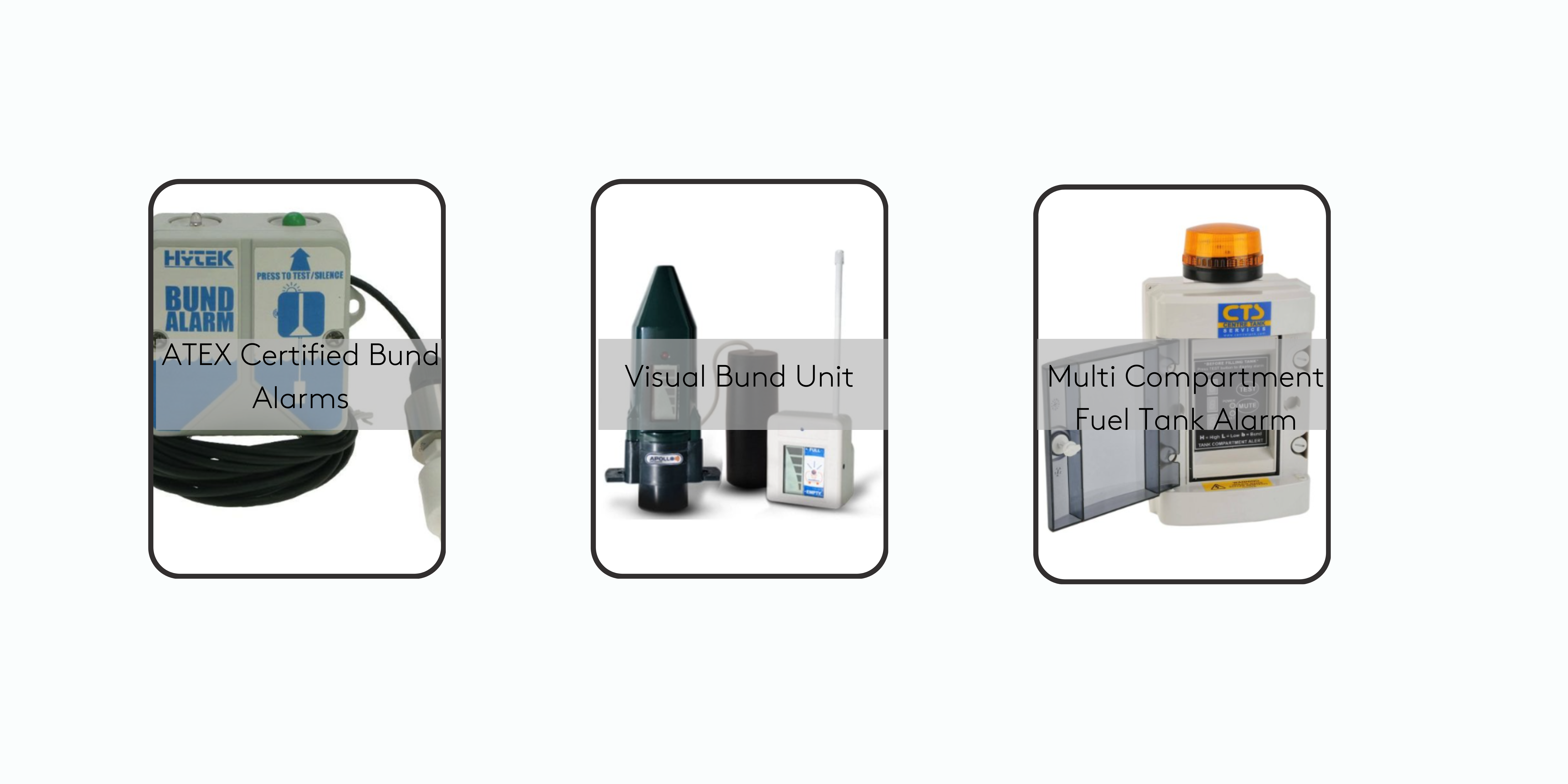
Fire Valves
Thermostatic Fire Valve
A thermostatic fire valve is a safety device designed to automatically shut off the fuel supply to a burner or heating system in the event of a fire. It operates based on temperature sensing, where if the temperature rises above a certain threshold, the valve activates and closes, preventing the flow of fuel. Thermostatic fire valves are crucial for preventing the spread of fire and minimizing the risk of accidents or damage in oil heating systems.
Pressure Regulating Valve
A pressure regulating valve, also known as a pressure control valve, is a device used to control and regulate the pressure of fluid or gas in a system. In the context of oil tanks, a pressure regulating valve helps maintain a consistent and safe pressure level within the tank, preventing over-pressurization. It ensures that the tank operates within the desired pressure range and protects the tank and associated equipment from potential damage or failure.
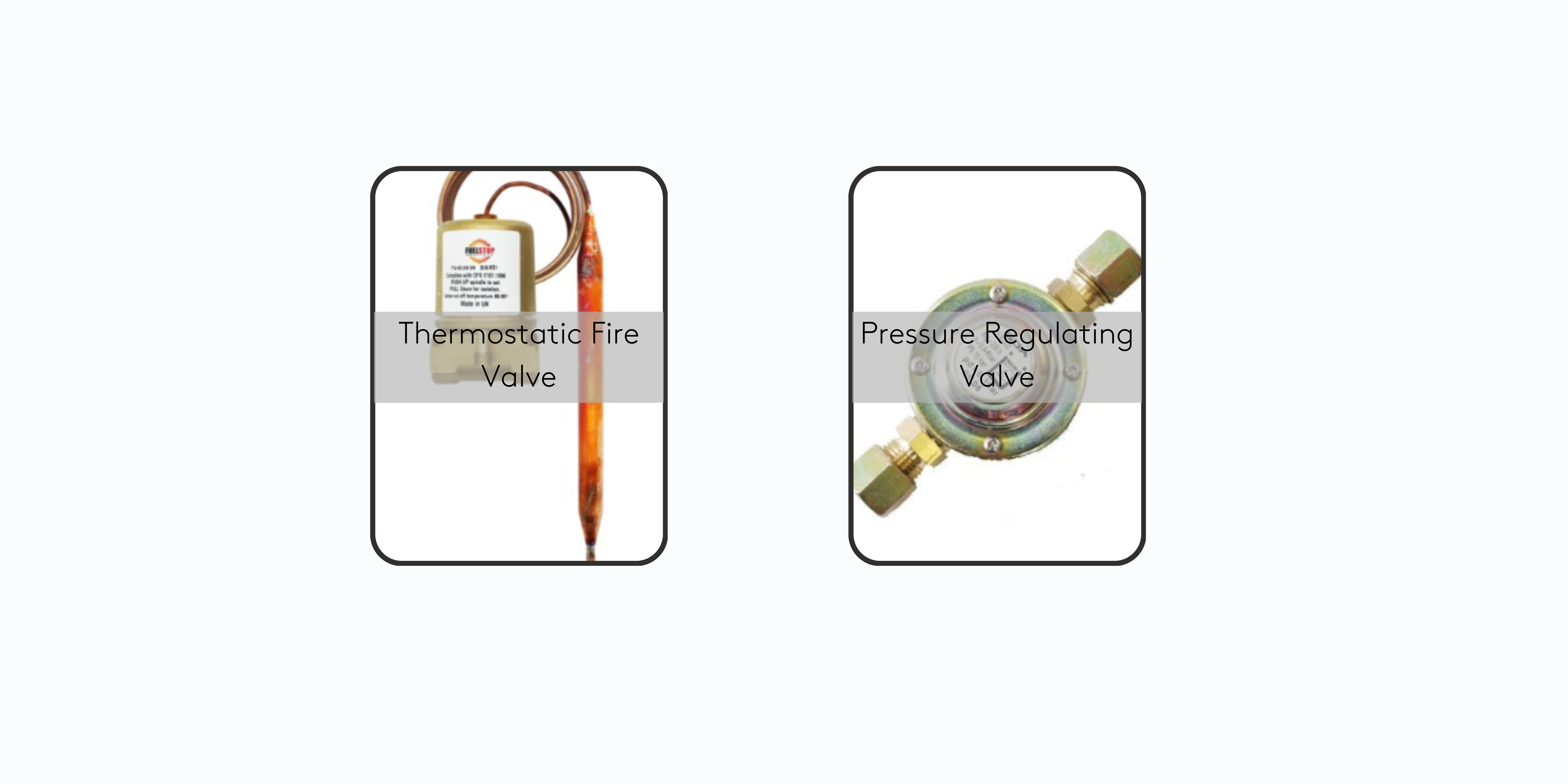
Tank Locks and Security
Lockable Filler Caps
Lockable filler caps are protective caps designed to secure the fill point of an oil tank. They feature a locking mechanism that prevents unauthorized access and tampering with the tank's contents. Lockable filler caps enhance security and prevent theft or contamination of oil stored in the tank.
Anti-Siphon Valve
An anti-siphon valve is a device installed in the oil tank's supply line to prevent unauthorized siphoning of oil. It acts as a one-way valve, allowing oil to flow into the tank but preventing reverse flow or siphoning. Anti-siphon valves help to deter theft and maintain the integrity of the oil supply.
Security Cages
Security cages are protective enclosures designed to safeguard oil tanks from unauthorized access, vandalism, or theft. These cages are typically made of sturdy materials such as steel and feature locked doors or gates. Security cages provide an additional layer of physical protection for oil tanks, enhancing security and deterring potential intruders.
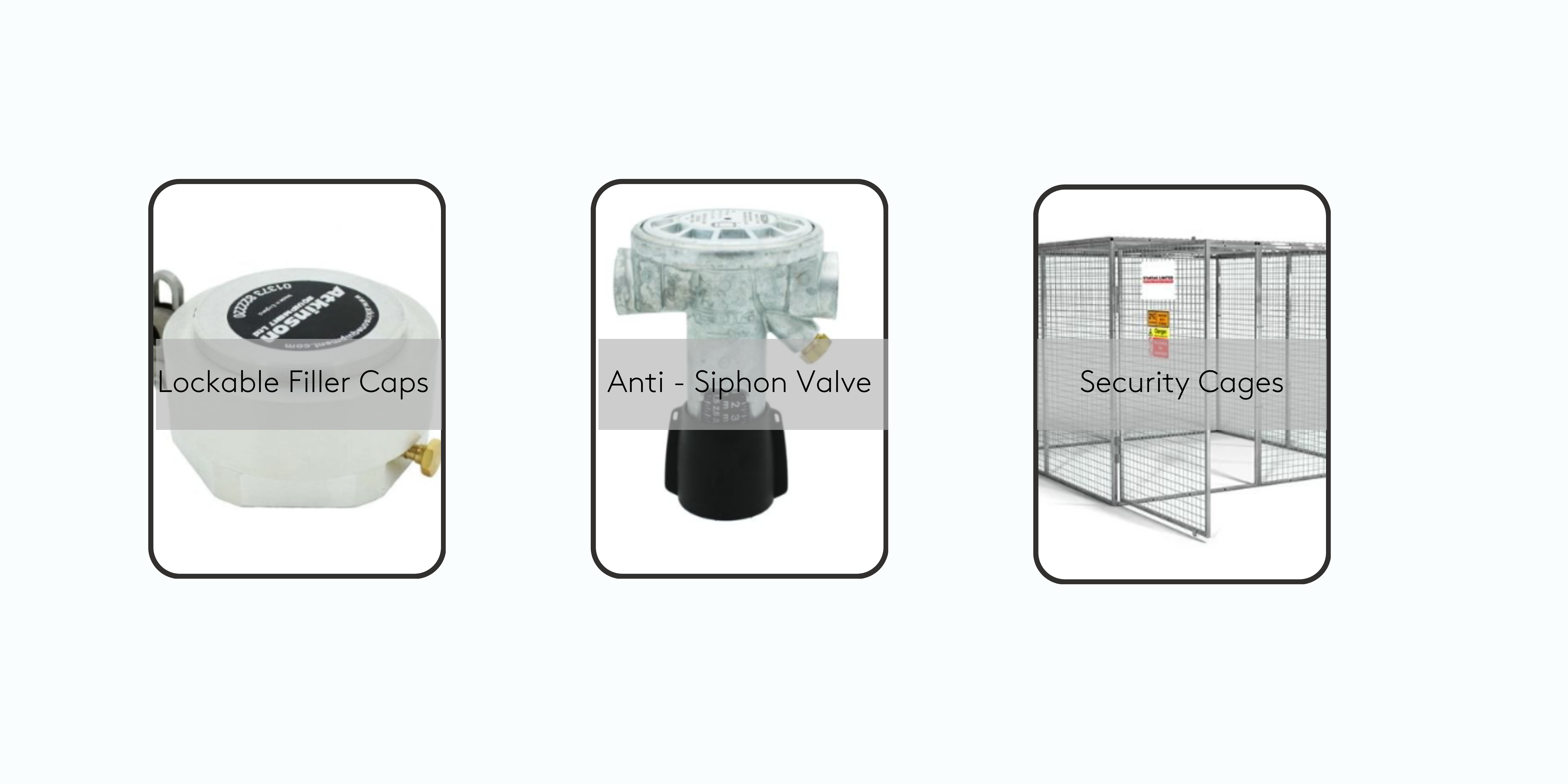
Tanks Lids and Caps
Retrofit Screw Caps
Retrofit screw caps are replacement caps designed to upgrade existing oil tanks with enhanced security features. These caps typically replace standard filler caps and incorporate additional security measures, such as locking mechanisms or tamper-evident features. Retrofit screw caps are easy to install and offer improved protection against unauthorized access and tampering.
Fill Point Caps
A fill point cap is a protective cap used to cover the fill point or opening of an oil tank. It helps prevent the entry of debris, dirt, or foreign objects into the tank, ensuring the cleanliness and integrity of the oil. Fill point caps also play a role in minimizing the risk of oil spills during the filling process and help maintain a secure and sealed tank.
Plug Cap
A plug cap, also referred to as a plug seal or plug cover, is a type of cap used to seal openings or access points in various equipment, including oil tanks. Plug caps provide a tight and secure seal, preventing leaks, contamination, or tampering. They are commonly used in situations where temporary or occasional access to the tank is required, and a reliable seal is needed when the access point is not in use.
Vent Cap
A vent cap is a cap or cover that is installed on the vent pipe of an oil tank. It serves as a protective barrier against the entry of debris, insects, or small animals into the tank through the vent. Vent caps also help to minimize the risk of rainwater or snow entering the tank, ensuring the quality and cleanliness of the oil.
Flap lid
A flap lid is a hinged cover or lid that is attached to an opening on an oil tank. It can be opened or closed manually, providing access to the tank when needed and sealing it securely when closed. Flap lids are commonly used on oil tanks for easy inspection, maintenance, or cleaning purposes. They help maintain the integrity and security of the tank while allowing convenient access for authorized personnel.
Vent Cowl
A vent cowl is a protective cover or cap that is installed on the vent pipe of an oil tank. It serves two purposes: to prevent the entry of debris, insects, or small animals into the tank through the vent, and to minimize the risk of rainwater or snow entering and potentially contaminating the oil. Vent cowls help maintain the cleanliness and integrity of the tank's ventilation system.

Oil De-Aerators
Oil Lifter
An oil lifter is a device used to extract oil from underground or submerged tanks. It utilizes a pump mechanism to lift the oil to the surface, enabling efficient and safe extraction. Oil lifters are commonly used in situations where direct access to the tank is not feasible or practical, such as underground storage tanks.
TigerLoops
TigerLoops are specialized oil de-aeration systems used in oil heating installations to remove air and ensure efficient oil flow. They help prevent problems such as oil burner lockout, excessive noise, and reduced system efficiency. There are various types of TigerLoops available, including:
TigerLoop Original: Designed for standard oil heating systems, it includes a TigerLoop de-aerator, an oil filter, and an isolation valve.
TigerLoop Bio: Specifically designed for use with biodiesel, it incorporates additional components to handle the unique characteristics of biodiesel fuel.
TigerLoop Combi: Suitable for both heating and generator applications, it combines a TigerLoop de-aerator with a fuel oil de-aerator.
These TigerLoop kits provide a complete solution for de-aerating oil and improving the performance and reliability of oil heating systems.

Water Removal
Water Soakers
Water soakers are devices or systems used to remove water from tanks or storage containers. They are designed to efficiently extract water that may have accumulated inside the tank due to condensation or other sources. Water soakers typically utilize absorbent materials or absorbent technology to soak up the water, helping to keep the tank dry and prevent potential issues such as corrosion or contamination.
Water Finding Paste
Water finding paste, also known as water detection paste or water detection compound, is a substance used to determine the presence of water in fuel tanks or other liquid containers. It is typically a paste-like material that changes colour when it meets water. By applying the water finding paste to a dipstick or probe and inserting it into the tank, the paste will change colour if water is present, providing a visual indication of water contamination. This helps in identifying and addressing water-related issues in tanks, ensuring the quality and performance of the stored liquids.
Tank Dryer
A tank's dryer is a device or equipment used to remove moisture or humidity from the air inside a tank. It is commonly used in applications where the stored contents are sensitive to moisture, such as certain chemicals or dry bulk materials. Tanks dryers typically employ air circulation and dehumidification techniques to reduce the moisture level inside the tank, helping to maintain the quality and integrity of the stored materials. They are particularly useful in environments with high humidity or fluctuating moisture levels.
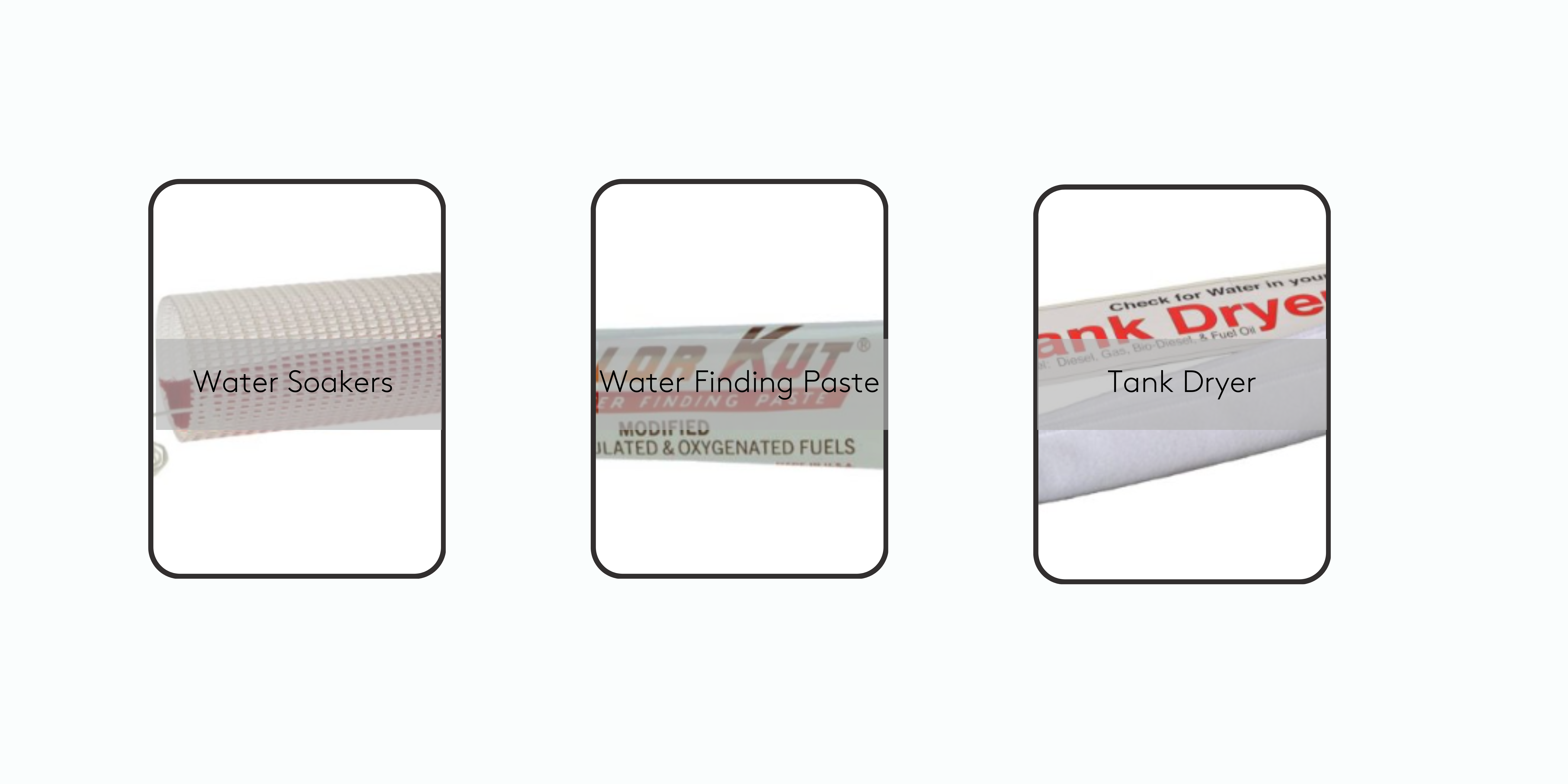
Read More From Fuel Tank Shop
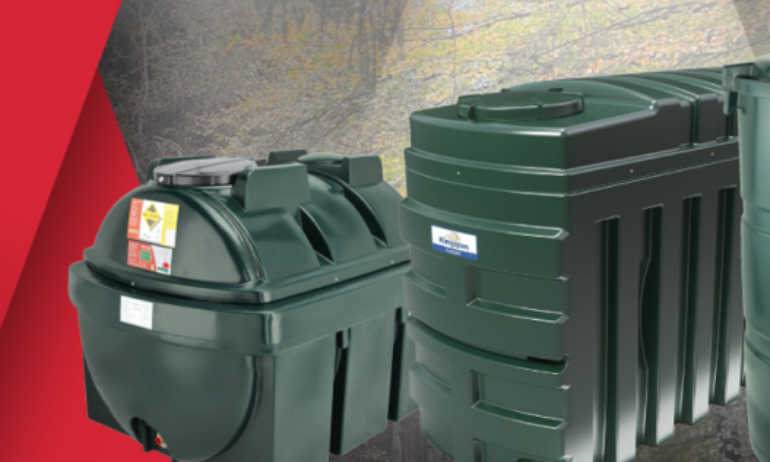
How To Prevent Heating Oil Theft
Read More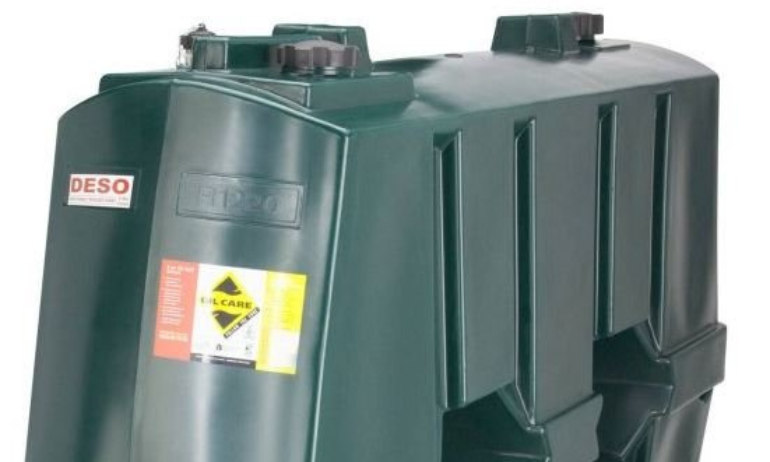
Single Skin Oil Tank Guide
Read More

 Login
Login